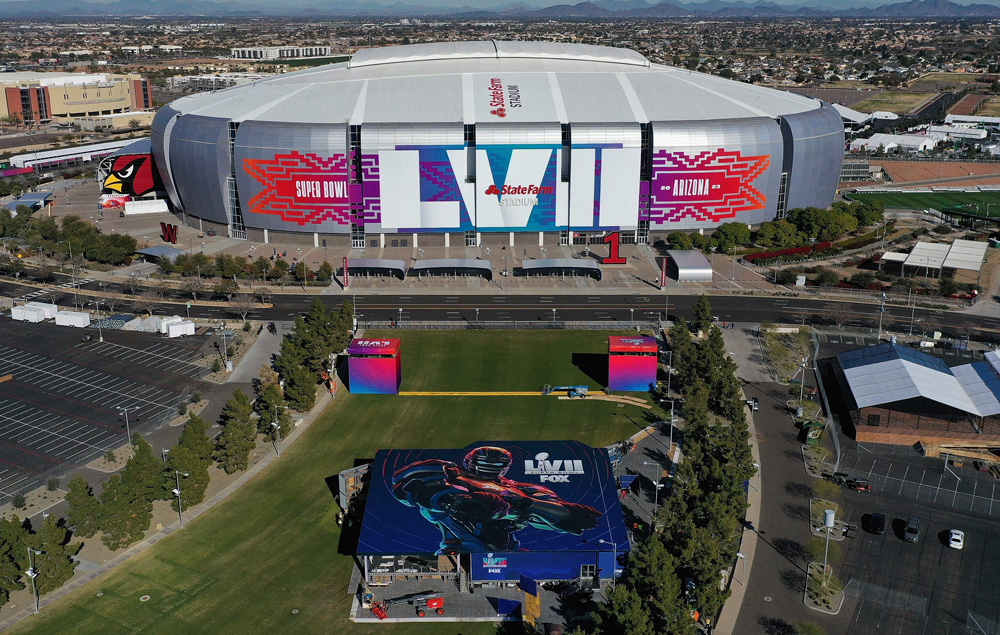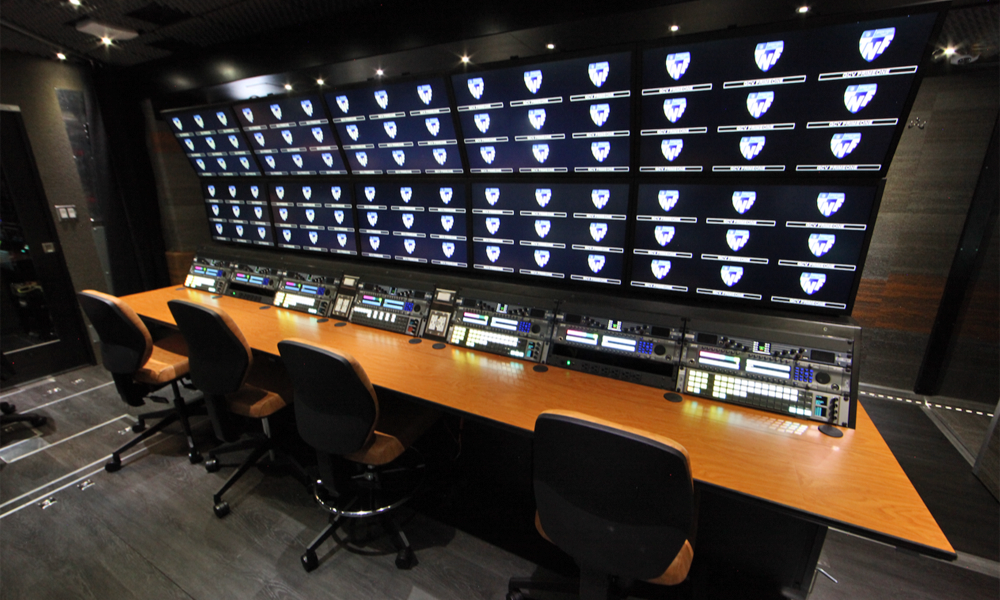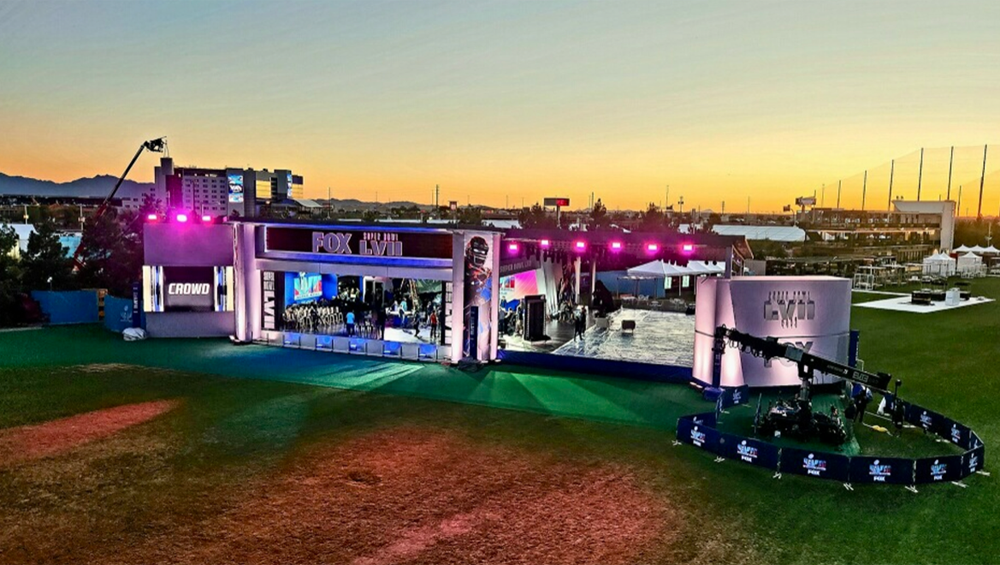
Fox Is Following Its IP Playbook For The Super Bowl

As it readies its coverage of Super Bowl LVII this Sunday from State Farm Stadium in Glendale, Ariz., Fox isn’t planning many audibles. While the Kansas City Chiefs and Philadelphia Eagles may be creating new offensive and defensive schemes to surprise each other, Fox is sticking with the same technology game plan it has used throughout the NFL season, albeit on a larger scale.
As it first did for the 2020 Super Bowl in Miami, Fox will be producing the game in 1080-line progressive HD at 59.94 frames per second with High Dynamic Range (known as 1080p/60 HDR). The 1080p HDR will be upconverted to 4K HDR for distribution through various cable and satellite operators as well as through the Fox Sports app, which is supported by numerous smart TVs and streaming devices. It downconverted to 720p SDR for traditional broadcast on Fox.

Michael Davies
HDR has become “much less experimental in the live venue” compared to three years ago in Miami, says Michael Davies, SVP of technical and field operations for Fox Sports. While at the 2020 game there were some SDR components that were upconverted to HDR (including the entire pregame show), everything on site in Glendale is HDR including the pregame and halftime shows. Fox used this all-HDR workflow throughout its NFL regular season “A” games as well as for its playoff coverage, which was offered in 4K HDR through the same distribution partners.
“The workflow hasn’t changed at all, it’s what we’ve done all season and certainly what we did at the NFC Championship,” Davies says. “But now we can say that the show is pure HDR for those who want to watch it that way.”
Game Creek Video’s Role
Underpinning Fox’s HDR production are IP-native mobile trucks from Game Creek Video that are networked using the SMPTE 2110 routing standard and connected to Fox’s data centers in Los Angeles and Tempe, Ariz. Game Creek’s Encore, which consists of three separate units, will serve as the game truck. Game Creek’s Prime One, a four-truck unit the vendor built last year for Amazon’s Thursday Night Football coverage, will support the pregame show. [Game Creek’s Centennial truck is also be used for the Super Bowl halftime show, which is being broadcast by Fox but produced by DPS].

Game Creek Video’s all-IP Prime One truck will support Fox’s pregame show.
“When you put two trucks together like that, one’s primarily for the game, and one’s primarily for the pregame,” Davies says. “But invariably the pregame [truck] winds up donating some space and equipment for the game, and Prime One was perfect for that.”
Key technology across the Game Creek trucks includes Sony cameras, EVS replay systems, Canon lenses, Vizrt graphics, Calrec audio boards, Grass Valley production switchers, and Evertz and Lawo IP-based routing systems. For augmented reality (AR) graphics, Fox will employ Epic’s Unreal Engine in combination with SMT’s real-time camera tracking software.
World Cup’s Flypacks Return
Fox will rely on nine mobile trucks in total, including the Game Creek trucks and an RF truck. And it is bolstering its technical capabilities onsite with the addition of two 2110-compliant “flypack” systems that it initially built to support its 2022 FIFA World Cup coverage in Qatar last fall.
The modular systems, which were specially designed to fold in half height-wise in order to fit in the cargo hold of a commercial airplane, were flown back from Doha and stored in a Phoenix warehouse before being pulled out for the Super Bowl. Later this year, the flypacks will travel to Australia for coverage of the 2023 FIFA Women’s World Cup.
The flypacks handle signals using Arista IP switches under the control of EVS’ software-based Cerebrum routing system and include TAG monitoring, Riedel intercom, EVS ingest and playback, and Grass Valley frame rate conversion and switcher systems. They tie into the Encore and Prime One trucks, Davies explains, serving as “sort of the third truck, without wheels.
“It’s all able to function as one big system, however, [it’s] compartmentalized,” he says. “So, if something were to happen, one thing doesn’t potentially take out everything else. When you build all this, it’s not only with production and expansion in mind; it’s also resiliency.”
With a large conventional mobile production fleet in Glendale, the flypacks aren’t being used to the same extent they were in Doha, but they are still playing a significant role. One flypack is performing distribution, subswitch, submix and disaster recovery functions, while the other unit is providing additional distribution capacity for Fox Desportes and various digital products. Those are tasks that Fox would have rented another truck to handle in the past.
“The thing about the Super Bowl and other enormous events is that you have a fairly big distribution responsibility for sending signals hither and thither to other takers,” Davies says. “That could be everything from replay to international to our post group to Pico, all of those things. This isn’t something that you do every single NFL game or every single big event. So, having this system that you are used to and has just done your big event, enables you not to reinvent the wheel with some other piece of equipment.
“That’s enormously helpful, and there’s the cost benefit of not having to rent the truck,” he says.
Fox is taking advantage of 2110 networking for greater flexibility and consistency in its production workflows. For example, the Grass Valley switchers incorporated into the Fox flypacks are the same ones used in the Game Creek trucks, says Greg Huttie, VP of switchers for Grass Valley.
“That panel is basically the same, the menuing is the same, the shows are built the same [way],” Huttie says. “So, a TD [technical director] is used to moving from one surface to another surface with a show, with a menu or anything else, all being the same. Therefore, they’ve got that continuity.”
A Familiar Venue
This year’s Super Bowl will be Fox’s 10th, and Davies’ sixth. His first was in 2008 at the same venue, then known as University of Phoenix Stadium. He is still impressed by the continued growth of the Big Game, which Fox is covering this week with a total of 50 hours of programming from Glendale across Fox, FS1 and Fox Deportes. That includes regular studio shows on Thursday and Friday and 7.5 hours of pregame on Sunday.
“When you look back at that event 15 years ago and what we have now, it’s amazing,” Davies says. “Not only TV, but just the event itself. We have some English engineers who have come across the pond to help us with some of the technical bits and they’re like, ‘Wow. You guys do all this for one day.’”
As the home of the Arizona Cardinals, State Farm Stadium is a familiar venue for Fox’s production team. But the stadium does present one major logistical challenge for a big event like the Super Bowl — its natural grass playing field is actually contained in a single, 40-inch-deep tray that measures 234 feet wide and 403 feet long and is rolled in and out of the stadium on a daily basis to ensure the grass gets the ideal mix of sun and shade.
The field tray thus eliminates a lot of potential parking spots until it is moved inside for the final time before the game, which wasn’t due to happen until last night. That has required Fox to park trucks farther away and also build two large tent areas to house offices and production spaces.
“We obviously have to park trucks earlier than that, so we have this weird parking configuration that works around this enormous field,” said Davies.
While in 2020 Fox had three pregame show locations in Miami including an elaborate multi-stage compound in South Beach, 18 miles away from the playing field, this year the network has concentrated its resources in Glendale to highlight the pregame action there. That includes building what Davies described as an “enormous set” on the Great Lawn outside the stadium, in the midst of the NFL’s “Game Day Experience” for ticketholders.

Fox has created a spacious set outside State Farm Stadium for its pregame show (Courtesy of Fox Sports).
The set’s total footprint runs 98 by 144 feet, including a demonstration field that measures 74×40. It includes 12 dedicated cameras, multiple LED displays and dedicated signage. The pregame show will be produced from the Great Lawn set until just before kickoff, when it will shift to a smaller set in the northeast tunnel of State Farm for final analysis and predictions.
In all, Fox will use at least 94 cameras in Glendale, including 44 game cameras, 18 pregame cameras and 16 robotic units. Specialty cameras include two SkyCams over the field (a high and a low), 13 pylon cameras and a drone. Fox will use 29 field-level microphones to capture game and player audio, among dozens of mics throughout the stadium, and rely on 20 miles of fiber and other cabling to transmit video, audio and data around the venue.
A technical highlight of the pregame show is a two-point FlyCam system that runs from the bottom of the Great Lawn up to the top edge of the stadium. That system, similar to ones previously used for the World Cup and World Series, “should give us a nice flying shot over the whole venue,” Davies says.
Pushing Augmented Reality
Three-dimensional AR graphics based on Epic Games’ Unreal Engine will also play a big role in the pregame show, with three cameras on Techocranes equipped with AR as well as the FlyCam. Fox has been pushing the use of AR instead of traditional graphics like lower-thirds and billboards since the start of the NFL season in its studio show from Los Angeles, where it has an LED volume that allows it to do both AR and XR (extended reality) graphics. It also used three AR cameras in its World Cup coverage last fall.
“It’s flowing along the same path that we’ve been doing the whole season, which is really trying to tell stories using AR,” says Zac Fields, SVP graphics technology and integration for Fox Sports.
Fox will also have two AR-equipped cameras in the stadium, including a SkyCam and a low-end-zone camera. The six AR units employ a variety of “calibration tactics” to allow Fox to place graphics in a 3D space, and different technologies including RF, traditional instrumentation and optical.
“It just really depends on what the camera is doing, and how we need to track it, so we can get the best data possible to achieve that effect,” Fields says.
He is particularly excited by an AR segment that is planned for the SkyCam about 30 minutes before kickoff, with a 3D graphic representing some of the key stories going into the game. During the game Fox may also show some AR graphics as the teams enter or exit the field, such as around halftime.
Fox also plans to use an “advanced telestrator” system to dissect the action in replays and packages. Instead of traditional telestration, where an analyst is essentially drawing lines on top of players, the AR-based tool uses the NFL’s playing tracking data to insert a 3D graphic that appears to be on the ground underneath the player. That way an analyst can display the route a receiver ran or the path a defensive end took to the quarterback before the replay rolls, and the viewer can then see the player move on top of the graphic without being obscured.
“It just helps the viewer know exactly what to look for,” Fields says.
High Speed, High Resolution
With many high-end professional cameras now having the ability to shoot at high frame rates for slow-motion replays, Fox has ratcheted up the total number of super-slo mo cameras to 32 to ensure a closer look at all pivotal plays.
“High-speed cameras are the name of the game,” Davies says. “We use them for replays, making sure you can see everything on the field — was the ball dropped, was a foot out of bounds, was it a touchdown — all of those things. It also works so well for emotion and the drama of the game. And our team in the ‘Two Riches’ [producer Rich Zyontz and director Rich Russo] know how to use those things for storytelling, not just analysis.”
Fox will also use a system from EVS called XtraMotion that interpolates frames from a camera running at a normal rate, such as a pylon cam, to create a super-motion effect when needed. And it is employing a dozen high-frame cameras shooting at 4K resolution or higher in key locations to allow a replay operator to extract part of a frame and zoom in for a closer look. Positions include high end zone, down the lines, on the goal lines and the SkyCams.
One of those high-resolution units will be an 8K camera placed at the reverse-50 camera position. That’s a nod to the 2008 Super Bowl, where the iconic shot of David Tyree’s “helmet catch” that helped the New York Giants beat the New England Patriots came from a Phantom Research ultra-high-speed camera at the reverse-50 position, Davies says.
“So, we put it back on the reverse-50, and it’s an 8K camera shooting at 120 fps, and we thought maybe we get lucky again from that position,” he says.
































Comments (0)